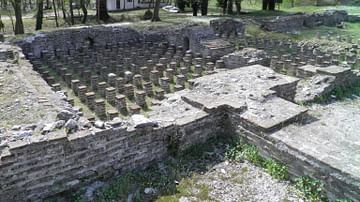Search Images
Browse Content (p. 587)

Image
Dion Polygonal Building, Greece
The Polygonal Building in Dion (Greece), located at the intersection of the main cardo and the decumanus (east-west road), is thought to have been a palaestra due to a mosaic depicting wrestlers that was found in one of the rooms.

Image
Medusa Mosaic from Dion, Greece
Mosaic floor from the Villa of Dionysus in Dion (Greece) depicting Medusa's head in a circular frame. 2nd century CE. Archaeological Museum, Dion.

Image
Praetorium of Dion, Greece
The praetorium of Dion in Macedonia (Greece) was a guesthouse used by visiting state officials as well as ordinary travellers. At Dion, it was located near the forum at the junction of the main cardo and the road leading to Mount Olympus.

Image
Dion Dionysus Villa, Greece
The Dionysus Villa in Dion in Macedonia (Greece) is a sprawling, luxurious private residence dating to the 2nd century CE. The villa complex was originally built with five interconnecting tetrastyle courtyards and atrium gardens. It was modified...

Image
Great Thermal Baths of Dion, Greece
The Great Thermal Baths were the largest and most lavish baths built in Roman Dion in Macedonia (Greece). They were built in the late 2nd century CE and abutted the southern city wall. The extensive underfloor hypocaust heating system and...

Image
Roman Odeum of Dion, Greece
The Roman Odeum of Dion in Macedona (Greece) was built in the late 2nd century CE. The small, covered theatre was used for concerts, plays, pantomimes, poetry, and musical performances. It had seating for around 400 spectators.

Image
Dion Hellenistic Theatre, Greece
The Hellenistic Theatre at Dion in Macedon with Mount Olympus in the background. The theatre was built into a natural hill during the 3rd century BCE. It underwent several phases of modification during the reign of Philip V (r. 221-179 BCE...

Image
Prince Henry the Navigator
A portrait by Nuno Gonçalves of Prince Henry the Navigator (aka Infante Dom Henrique, 1394-1460), one of the prime instigators of the Portuguese Empire. (National Museum of Art, Lisbon)

Image
Mount Pico, Azores
Mount Pico in the Azores archipelago, North Atlantic. 2,351 metres (7,713 ft).

Image
Jennifer Saint
Jennifer Saint, author of Ariadne.
Photo by Jo Murricane